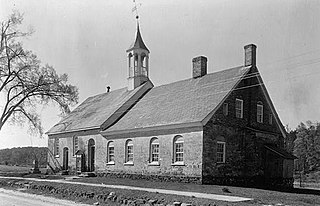
Bethabara Historic District encompasses the surviving buildings and archaeological remains of a small Moravian community, that was first settled in 1753. Located in present-day Forsyth County, North Carolina, it is now a public park of the city of Winston-Salem. It was designated National Historic Landmark in 1999.

The Single Brothers' House was built to house the Single Brethren, the unmarried men, of the Moravian Congregation of Salem, now Winston-Salem, North Carolina. It is part of Old Salem Museums & Gardens and open as an Old Salem tour building to visitors. It is located at 600 South Main Street, at Academy Street, on the southwest corner.

Hillsborough Historic District is a national historic district located at Hillsborough, Orange County, North Carolina. The district encompasses 529 contributing buildings, 9 contributing sites, 13 contributing structures, and 2 contributing objects in the central business district and surrounding residential sections of Hillsborough. The district includes buildings dating to the late-18th and early-20th century and includes notable examples of Federal, Greek Revival, and Italianate style architecture. Located in the district are the separately listed Burwell School, Eagle Lodge, Hazel-Nash House, Heartsease, Montrose, Nash Law Office, Nash-Hooper House, Old Orange County Courthouse, Poplar Hill, Ruffin-Roulhac House, Sans Souci, and St. Matthew's Episcopal Church and Churchyard. Other notable buildings include Seven Hearths, the Presbyterian Church (1815-1816), Methodist Church (1859-1860), First Baptist Church (1862-1870), Twin Chimneys, and the Berry Brick House.
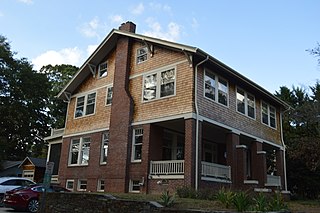
Cameron Park, now Forest Park, is a historic neighborhood just west of downtown Raleigh, North Carolina, one of three suburbs platted in the early 20th century. It’s one of Raleigh’s most affluent neighborhoods. Governor Roy Cooper has a home there as well as the state’s attorney general Josh Stein and N.C. State’s chancellor Randy Woodson. Development began along Hillsborough Street and moved north; a streetcar line along Hillsborough made the location especially appealing and convenient. Cameron Park's developers used restrictive deed covenants that set minimum house prices, created setbacks from the street, and excluded African Americans from living in the neighborhood. Advertisements for Cameron Park openly recruited socially ambitious upper-middle class residents to the neighborhood, and land and house values were significantly higher than those of other early suburbs.
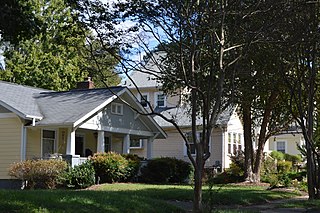
The Ardmore Historic District is a 600-acre (240 ha) national historic district located at Winston-Salem, Forsyth County, North Carolina. The district encompasses 2,093 contributing buildings and two contributing sites. The district consists of at least ten platted residential developments from 1910 through 1924 as well as three large apartment complexes from 1947 through 1951, one of which was controversially demolished in 2021. It includes works designed by Hall Crews and by Northup & O'Brien. It includes Queen Anne and Bungalow/craftsman architecture.

North Green Street–Bouchelle Street Historic District is a national historic district located at Morganton, Burke County, North Carolina. It encompasses 37 contributing buildings in a predominantly residential section of Morganton. It includes buildings built between about 1876 and 1935, and includes representative examples of Colonial Revival, Bungalow / American Craftsman, and Late Victorian style architecture. Located in the district is the separately listed Alphonse Calhoun Avery House.

Salem Street Historic District is a national historic district located at Thomasville, Davidson County, North Carolina, United States. The district encompasses 33 contributing buildings in a predominantly residential section of Thomasville. They were built between about 1861 and 1957, and include notable examples of Queen Anne and Colonial Revival style architecture. Notable buildings include the Heidelberg Church, St Paul's Episcopal Church, White House, Strickland-Long House, Morris-Harris House, and Leon A. Kress House.

Centerville Historic District is a national historic district located at Winston-Salem, Forsyth County, North Carolina. The district encompasses 91 contributing buildings and 1 contributing structure in Winston-Salem. It includes a mix of residential, commercial, and light industrial buildings built between about 1900 and 1950. Residential buildings are in a mix of popular architectural styles including Queen Anne, Bungalow / American Craftsman, and Minimal Traditional.

Downtown North Historic District, also known as Trade Street District, is a national historic district located at Winston-Salem, Forsyth County, North Carolina, USA. The district encompasses 46 contributing buildings in a commercial section of Winston-Salem. They were built between about 1907 and 1952, and most are one- or two-story brick buildings, sometimes with a stuccoed surface. Notable buildings include the Beaux-Arts style former United States Post Office with an addition by Northup and O'Brien, Brown-Rogers-Dixson Company Building (1928), Centenary Church Education Building (1920s), Pure Oil Station, City Market (1925), and Twin City Motor Company (1925).
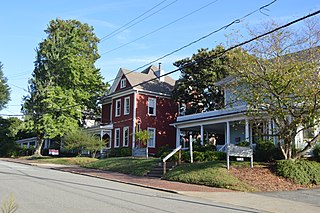
Holly Avenue Historic District is a national historic district located at Winston-Salem, Forsyth County, North Carolina. The district encompasses 115 contributing buildings and 1 contributing site in a predominantly residential section of Winston-Salem. The buildings date between about 1885 and 1952, and include single family dwellings and apartment building. The include examples of late-19th and early-20th popular architectural styles including the Queen Anne and Italianate style. Notable buildings include the Henry Case House, James Jessup House, Henry Foltz bam (1906), Calvary Moravian Church (1923), T. R. Brann's store, and Green Front Grocery.

North Cherry Street Historic District is a national historic district located at Winston-Salem, Forsyth County, North Carolina. The district encompasses 62 contributing buildings and 1 contributing object in a historically African-American residential section of Winston-Salem. The buildings date from about 1925 to 1951, and include notable examples of Colonial Revival and Bungalow / American Craftsman style architecture.

Sunnyside–Central Terrace Historic District is a national historic district located at Winston-Salem, Forsyth County, North Carolina. The district encompasses 425 contributing buildings in a predominantly residential section of Winston-Salem. The buildings date from about 1892 to 1958, and include notable examples of Colonial Revival, Late Victorian, and Bungalow / American Craftsman style architecture. Notable buildings include the Arista Mills (1950), Farmers Cooperative Exchange, Southern Steel Stampings, E. T. Baity Oil Co., Central Terrace Methodist Church, and Pine Chapel Moravian Church (1928).

Washington Park Historic District, also known as the Southside Neighborhood, is a national historic district located at Winston-Salem, Forsyth County, North Carolina. The district encompasses 348 contributing buildings, 1 contributing site, and 2 contributing structures, in a predominantly residential section of Winston-Salem. It was a planned speculative development centered on a streetcar line. The buildings date from about 1892 to 1940, and include notable examples of Colonial Revival, Queen Anne, and Bungalow / American Craftsman style architecture. Notable buildings include the Schlatter Memorial Reformed Church (1916).
West End Historic District is a national historic district located at Winston-Salem, Forsyth County, North Carolina. The district encompasses 508 contributing buildings and 7 contributing structures, in a predominantly residential section of Winston-Salem. It was a planned picturesque streetcar suburb developed at the turn of the 20th century. The buildings date from about 1887 to 1930, and include notable examples of Classical Revival, Colonial Revival, Queen Anne, and Bungalow / American Craftsman style architecture. Located in the district are the separately listed H. D. Poindexter Houses and Zevely House. Other notable buildings include the St. Paul's Episcopal Church (1928-1929) designed by Ralph Adams Cram, Augsburg Lutheran Church (1926), Friends Meeting House (1927), the First Church of Christ, Scientist (1924), and Joyner's West End Grocery.

Waughtown–Belview Historic District is a national historic district located at Winston-Salem, Forsyth County, North Carolina. The district encompasses 1,137 contributing buildings, 1 contributing site, and 1 contributing object in a largely residential section of Winston-Salem. The buildings date from about 1834 to 1955, and include notable examples of Greek Revival, Colonial Revival, Queen Anne, and Bungalow / American Craftsman style architecture. Located in the district is the separately listed Shell Service Station. Other notable resources include the Clodfelter House, Fiddler House, Nissen Wagon Works smokestack, Triangle Body Works, Waughtown Baptist Church (1919), Waughtown Presbyterian Church (1914), Southside Christian Church, and Waughtown Cemetery.

Winston-Salem Tobacco Historic District is a national historic district located at Winston-Salem, Forsyth County, North Carolina. The district encompasses 16 contributing buildings and 16 contributing structures in a predominantly industrial section of Winston-Salem. The buildings date from about 1890 to 1959, and include buildings relating to the tobacco industry, specifically R. J. Reynolds Tobacco Company. Also on the district are a once-thriving African American and the wholesale commercial business district that once catered to the R. J. Reynolds Tobacco Company workers. Located in the district is the separately listed Romanesque Revival style S. J. Nissen Building and Piedmont Leaf Tobacco Company.
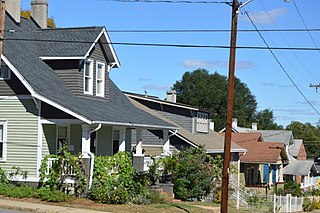
West Salem Historic District is a national historic district located at Winston-Salem, Forsyth County, North Carolina. The district encompasses 591 contributing buildings, 1 contributing site, and 3 contributing structures in a largely residential section of Winston-Salem. The buildings date from about 1843 to 1957, and include notable examples of Colonial Revival, Queen Anne, and American Craftsman style architecture, as well as bungalows. Notable resources include the M. D. Gantt Building (1931), Coca-Cola Bottling plant (1930), Christ Moravian Church (1895), and Green Street Methodist Church (1921).

Oxford Historic District is a national historic district located at Oxford, Granville County, North Carolina. The district encompasses 201 contributing buildings, 1 contributing site, and 2 contributing objects in the central business district and surrounding residential sections of Oxford. It includes buildings dating from the early-19th century through the 1930s and notable examples of Greek Revival and Late Victorian style architecture. Located in the district is the separately listed Granville County Courthouse (1838-1840). Other notable buildings include the Bryant-Kingsbury House, Taylor-McClanahan-Smith House (1820s), former Granville County Jail, Oxford Women's Club, Titus Grandy House (1850s), Oxford Presbyterian Church, St. John's College, Lyon-Winston Building (1911), Herndon Block Number 2, Hunt Building, L. H. Currin-American Tobacco Company (1860s), and St. Stephens Episcopal Church (1902).

Fisher Park Historic District is a national historic district in the Fisher Park neighborhood, Greensboro, Guilford County, North Carolina. The district encompasses 541 contributing buildings, 2 contributing sites, and 44 contributing structures in a predominantly residential section of Greensboro. The houses were largely built between the 1900s and 1930s and include notable examples of Queen Anne, Colonial Revival, Gothic Revival, American Foursquare, and Bungalow / American Craftsman-style architecture. Located in the district are the separately listed Dixon-Leftwich-Murphy House, John Marion Galloway House, Julian Price House, and Latham-Baker House. Other notable buildings include the First Presbyterian Church (1928), Holy Trinity Episcopal Church (1922), Gant-McAlister House, and A.J. Schlosser House.
Willard Close Northup (1882–1942) was an American architect in North Carolina who was the principal partner in the firm Northup & O'Brien. His firm was based in Winston-Salem, North Carolina. Northup began his architectural practice in 1906 and partnered with Leet Alexander O'Brien (1891–1963) in 1915 or 1916. Luther Lashmit joined the firm in 1927, and was lead architect for Graylyn while an employee of the firm.






















